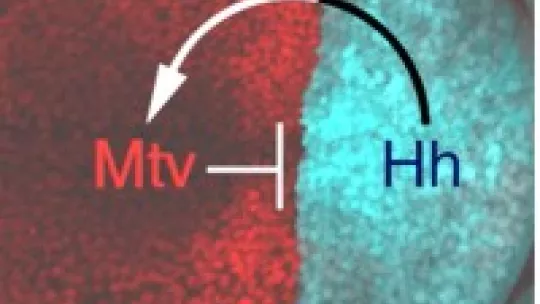Images
The protein Hedgehog is fundamental to the development of multiple organs. Errors in its expression are linked to skin cancer.
Using the fruit fly as a model, a team of scientists, led by Marco Milán, at the Institute for Research in Biomedicine (IRB Barcelona) have discovered a new molecular mechanism whereby a protein called Hedgehog represses its own expression. Hedgehog activates a series of biochemical reactions that involve a large number of genes and other proteins. The complex interaction among these molecules is known as “Hedgehog signalling pathway” and is fundamental to the embryonic development of organisms including flies, mice and humans. The mutations of certain proteins involved in this pathway have been associated with several types of cancer and other human diseases.
This finding would open the way to explore the different components of the Hedgehog autosuppression mechanism as possible therapeutic targets.
Observations in the Drosophila wing have revealed that the Hedgehog protein induces a nuclear protein called MTV. This protein then combines with a transcriptional co-repressor called Groucho, which together with other molecules, represses the hedgehog gene. According to Marco Milán, the molecular system involved in the repression of the hedgehog gene may play a role in the development of certain types of cancer. For the ICREA researcher based at IRB Barcelona, and expert in developmental biology, the next step is to identify whether it is components of the repression complex that fail in some types of cancers caused by inadequate expression of hedgehog. This finding would open the way to explore the different components of the Hedgehog autosuppression mechanism as possible therapeutic targets.
Other signalling molecules, such as Notch, Wnt and TGF-, which transmit messages across the cell membrane to the cell nucleus and activate other pathways involved in different processes, also have mechanisms that restrict their own expression or activity. Multicellular systems have armed themselves with many silencing mechanisms, indicating that although it is essential for certain pathways to be expressed at a certain time, adds Milán, it is much more important for these pathways to remain silent in order to avoid the development of pathologies.
All these proteins and their signalling pathways are perfectly preserved in evolution and function identically in all vertebrates, including humans. “Once again, studies that have used the Drosophila fly as a model system have proven to be extremely useful to discover basic molecular mechanisms and components that enable us to make headway in the study of human diseases”, concludes the researcher. This study appeared recently in the online version of EMBO Reports.
Reference article:
Hedgehog restricts its expression domain in the Drosophila wing
Bejarano F., Pérez L., Apidianakis Y., Delidakis C., Milan M.
EMBO Rep. Epub ahead of print, Jun 15 (2007)
About IRB Barcelona
The Institute for Research in Biomedicine (IRB Barcelona) pursues a society free of disease. To this end, it conducts multidisciplinary research of excellence to cure cancer and other diseases linked to ageing. It establishes technology transfer agreements with the pharmaceutical industry and major hospitals to bring research results closer to society, and organises a range of science outreach activities to engage the public in an open dialogue. IRB Barcelona is an international centre that hosts 400 researchers and more than 30 nationalities. Recognised as a Severo Ochoa Centre of Excellence since 2011, IRB Barcelona is a CERCA centre and member of the Barcelona Institute of Science and Technology (BIST).





